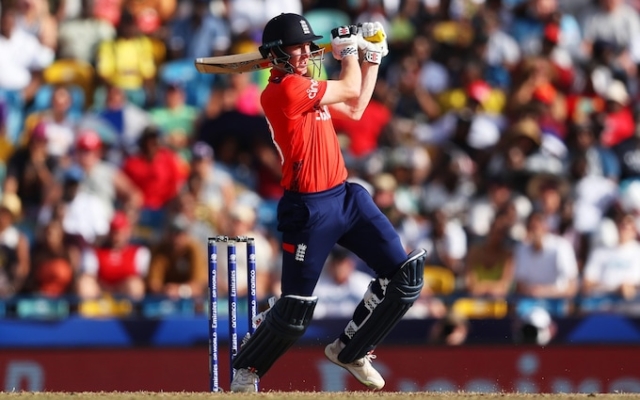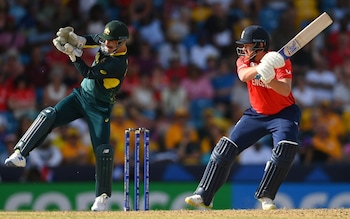 Harry Brook was not given a fair chance to make an impact against Australia By: Getty Images/Matthew Lewis
Harry Brook was not given a fair chance to make an impact against Australia By: Getty Images/Matthew Lewis
When Harry Brook was called up, the position It was almost beyond repair for England in their second T20 World Cup match. Brook came out in Barbados with England four wickets down and needing another 78 off 35 balls: tough against any opposition, let alone one against Australia's bowling.
And so it turned out. In December in Grenada, Brook won from an even more dismal position, making 31 not out from seven balls after arriving with England needing 40 runs from 13 innings. On a less scoring wicket, against a stronger attack, Brook struggled for the same fluency.
It took him until the 13th ball, by which time an English victory was mathematically impossible, for Brook to hit his first boundary, finishing with 20 not out from 16 balls.
Yet Brook's efforts were still more convincing than those of the man he replaced at the crease. Jonny Bairstow made just seven off 13 balls, repeatedly running unconvincingly over the line before he struck the ball out to long-on.
 Jonny Bairstow failed to impress Australia. Photo: Getty Images/Gareth Copley
Jonny Bairstow failed to impress Australia. Photo: Getty Images/Gareth Copley
At the heart of the task of creating a T20 batting line-up is to give the team's best players the opportunity to have the greatest impact on the game. When Australia lost to England in the T20 World Cup final at Bridgetown in 2010, one of the reasons was that their best batsman, Mike Hussey, was down to seventh and played just 10 balls. If Brook isn't already as dangerous as Hussey, Australia would be content to hold him back until sixth place in Barbados.
While Brook's white-ball record for England has yet to match his Test achievements, the precision and range of his strike-action make him one of England's most feared batsmen. He has now hit six for every 15 balls in his international T20 career. That explosiveness has underpinned some devastating innings — a 35-ball 81 not out in Karachi, a 29-ball 46 not out in Lahore and a stunning heist against the West Indies last year.
All of these achievements have come at number five or six, where Brook has batted for much of his England T20 career. On the only occasion Brook has challenged for the number four spot, against New Zealand last summer, he hit 43 not out from 27 balls and then 67 from 36 – both to secure victories. Those performances underlined Brook’s suitability at number four, controlling the innings; however, he has since been dropped from the order.
Allowing Brook to bat at four will force England to make tough decisions elsewhere. Bairstow has a superb track record at clearing the ropes; he hit 108 from 48 balls, including nine sixes, in the Indian Premier League just six weeks ago.
This performance took place during the opening. England's abundance of opening options, as well as Bairstow's ability to counter spin, means he occupies a relatively unfamiliar position in international cricket: Saturday marked only the third time he has bowled just his fourth number in any T20 match since July 2022. England must now assess whether Bairstow can provide the weight the team needs at five or six, or whether he should now be forced out of the team.
Selecting Curran would allow England to break up their right-handers.
If Bairstow is dropped, Ben Duckett will be the obvious replacement. Duckett has been selected as the team's reserve specialist batsman. Luckily, he is also a left-hander.
But for all of Duckett's improvisation and agility against spin, he will waste time batting outside the top four. Its relative lack of power is also ill-suited to the unique nature of T20 in the Caribbean, where a combination of short boundaries and some uneven bounce means teams regularly hit as many sixes as fours.
Instead, Sam Curran is better suited to T20 demands in the West Indies. Since the start of 2022, Curran has scored six for every 16 in all T20 games; During this period, Duckett scored just one ball for every 44. Selecting Curran would have allowed England to break up their right-handers in the middle order, using Moeen Ali and Curran at number five and seven, with Liam Livingstone sandwiched between them at number six. Selecting Curran will also bring another benefit: his bowling.
Although his man of the tournament in the last T20 World Cup is increasingly looking like a perfect storm, Curran will still provide England with a man who can bowl. in all three phases of the game. In this line-up, Curran could not be relied upon to complete all four overs, allowing England flexibility in how they used his bowling. Curran's last match gave a tantalizing hint of his capabilities as he opened the bowling and took 2-24 in three overs before guiding the Punjab Kings to victory with an unbeaten 63 off 41 balls at No. 5.
Fixture Curran would give England an extra chance to crack the top seven. On Antigua's slow, twisty tracks, Curran's presence could allow England to learn from the West Indies and realize the value of slow left-arm spin. Tom Hartley, who has already shown interest in competing in international cricket, could be selected as the second frontline spinner alongside Adil Rashid.























































Свежие комментарии